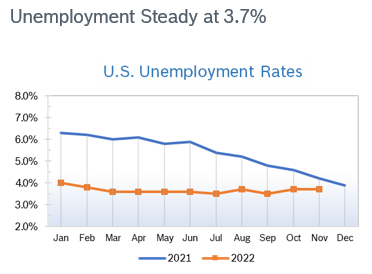|
Stocks soared at the end of the month as investors were encouraged by remarks by Fed Chairman Jerome Powell that seemed to confirm that the rate and pace of interest rate increases could slow down as inflation cools off. Consumer Spending Rises 0.8% Consumer spending rose 0.8% in October after rising 0.6% in September. The increase was about twice as much as economists expected. Core consumer spending rose 0.5% in October after rising 0.3% in September. Spending on goods increased 1.4%, driven by purchases of motor vehicles, furniture and recreational goods. Outlays on services gained 0.5%, lifted by spending at restaurants and bars, as well as on housing and utilities. Strong wage gains and holiday promotions fielded in October helped fuel spending. Personal income rose 0.7%, the most in a year. Disposable income, adjusted for inflation, rose 0.4%. Consumers also tapped into savings to fund purchases. The savings rate dropped to 2.3%, the lowest since July 2005, from 2.4% in September. The saving rate was as high as 26.3% in March 2021. It is now near levels seen during the 2007-09 Great Recession.
Chicago PMI Drops to 37.2 The Chicago PMI dropped sharply to 37.2 in November after falling to 45.2 in October. It was the lowest level for the PMI since the onset of the pandemic in 2020. Economists had expected the PMI to rise into the 47+ range. A PMI number above 50 signifies expanded activity over the previous month; readings below 50 signify contraction. Looking back to when the series began in 1967, the PMI has ranged from 20.7 in June 1980 to 81.0 in November 1973. Wholesale Prices Rise 0.2% The Producer Price Index (PPI) rose 0.2% in October, below the 0.4% estimate. The PPI rose 0.4% in September. A significant contributor to the slowdown in wholesale inflation was a 0.1% decline in services, the first outright decline in that measure since November 2020. On a year-over-year basis, PPI rose 8% compared to an 8.4% increase in September. Q3 GDP Rises 2.9% Q3 GDP rose an upwardly revised 2.9%, according to the second reading from the Commerce Department. Upward revisions in consumer and business spending accounted for much of the revised growth. Residential investment contracted for the sixth consecutive quarter. When measured from the income side, the economy grew at a 0.3% rate. Gross domestic income (GDI) had contracted 0.8% in the second quarter. In principle, GDP and GDI should be equal, but in practice they generally diverge as they are estimated using different and largely independent source data. The average of GDP and GDI, also referred to as gross domestic output and considered a better measure of economic activity, increased 1.6% in the third quarter after shrinking 0.7% in the second quarter. Real personal consumption expenditures (PCE), which account for roughly two-thirds of spending, rose an annualized 1.4% in Q3. Spending on durable goods, which tends to be sensitive to higher interest rates, edged down by 0.8%, while spending on non-durable goods slid 1.4%. Spending on services, which is still being boosted significantly by pent-up demand, grew 2.8%. Rapidly rising mortgage rates contributed to residential investment plunging by more than 26% in Q3. Residential investment has declined by more than 15% since peaking in early 2021. © Robert Bosch Tool Corporation. All rights reserved, no copying or reproducing is permitted without prior written approval.
Comments are closed.
|
|









